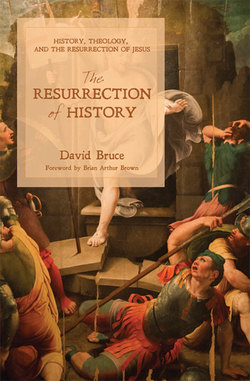Читать книгу The Resurrection of History - David Prewer Bruce - Страница 4
На сайте Литреса книга снята с продажи.
Preface
ОглавлениеAbout twenty-five years ago, during my basic ministry studies with the United Church of Canada in Toronto, I wrote a brief paper on the symbolism of the resurrection of Jesus. In that short essay I argued that deciding whether the resurrection of Jesus was a historical event or simply an image of perennial truth would affect its symbolic value. The only trouble was that I had no idea what I was talking about, beyond that bare intuition. Twenty-five years and two doctorates later, I might confidently say I have half a clue—if only half. I am, however, like a wee lad with five loaves and a couple of fish, happy to share what I have with you.
I began my career in pastoral ministry believing that Jesus’ resurrection was little more than a motif of hope, even if you would never have known it from my overly cautious sermons. I did believe that Jesus’ resurrection was a historical event (though not necessarily a bodily one), and that God had done something within human history, but I largely lacked the conceptual apparatus to make much of a case for that. In this regard, I seemed to be well in step with my mainline Protestant colleagues.
The old Latin proverb lex orandi, lex credendi has often been quoted, and in my case it bore out. As I continued to preach, I grew more skeptical of my own position on the resurrection. I was finally caught up one fateful afternoon in a new-members class for a congregation I was serving, in which my wife Janet had decided to take part. She openly admitted to those gathered (and yes, I have permission to tell the story!) that she didn’t believe in the resurrection or even in life after death, but that she hoped to live on in the memory of our children. There was stunned silence in the group. I finally ventured out, again more cautiously than is my natural bent, and commented, “Easter must be a bummer for you.” We all laughed—which was the desired outcome, but Janet said that yes, she had always felt a little alienated by the language of Easter.
That class was a great turning point for me. I soon enrolled in a doctor of ministry program in a leading seminary in order to critically examine both the content and process of my parish teaching. The result was—to my surprise—an increasing commitment to the orthodoxy of the ancient church and the importance of catechesis, and the publication of Jesus 24/7: A Short Course in Faith for the Questing Christian.1 In that resource, I reaffirmed, in mainline Protestant language, the classic doctrines of the Trinity, the incarnation, and yes, the bodily, historical resurrection of Jesus. It seems that I wasn’t alone in my interest to revisit the roots of Christian faith; even in my very liberal tradition, my little book sold very well, and was followed by Jesus 24/7 Youth!, Jesus 24/7 Guide to the Bible, and Jesus 24/7 Guide to Spiritual Growth.
Having positioned myself as a teacher, however, I realized that I still had much to learn, and so I returned to the specific question of the resurrection of Jesus in a second set of doctoral studies, this time at the Toronto School of Theology of the University of Toronto. At the urging of my supervisor Michael Bourgeois, my mentor Harold Wells, and my instructor and often-muse Fr. Gilles Mongeau, I made a study of historiography and historical method, and examined the question of what it would mean to declare the resurrection of Jesus to be a historical event. The result was a thesis with the sleep-inducing title (as all dissertations seem to have), “The Theological Implications of Declaring the Resurrection of Jesus to Be Historical.” In it I traced the dialectical relationship between shifting historiographical trends and academic theology, especially where it concerned the resurrection of Jesus.
Along the way I had also begun exploring classic Christian spirituality, at least in its Western form. I began praying the Liturgy of the Hours, sneaking off to attend Mass whenever possible. I took detailed, in-depth catechetical instruction from the late Fr. Terrence Walsh, SJ, while under the wise and gentle spiritual direction of Ignatius Feaver, OFM. It was a seven-year journey that ended with my leaving the United Church of Canada and being received into the Catholic Church in July of 2011. I took up rich and satisfying work with homeless and marginalized men at the Good Neighbours’ Club in downtown Toronto while becoming increasingly involved in the day-to-day life of the Catholic Church as a layperson. I still run retreats, lead small groups, publish articles here and there (most recently writing the “Introduction to the Gospels” in Brian Arthur Brown’s Three Testaments: Torah, Gospel, Quran,2 and in these efforts seek to share my handful of insights with fellow travellers on life’s journey.
My gratitude goes out to my longsuffering wife Janet, my now-grown children Heather, Geoffrey, and Paul, my mentors at the Toronto School of Theology, the wonderful Friars and my fellow parishioners at the Conventual Franciscan Parish of Saint Bonaventure, and to my publisher for enabling me to connect with you.
1 Toronto: United Church, 2008.
2 Lanham, MD: Rowman & Littlefield, 2012.
